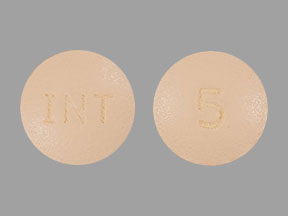Obeticholic Acid Dosage
Medically reviewed by Drugs.com. Last updated on Jun 13, 2023.
Applies to the following strengths: 5 mg; 10 mg
Usual Adult Dose for:
Additional dosage information:
Usual Adult Dose for Biliary Cirrhosis
Initial dose: 5 mg orally once a day
Maintenance dose: 5 mg orally once a day; if adequate reduction in alkaline phosphatase (ALP) and/or total bilirubin is not achieved after 3 months, increase the dosage to 10 mg orally once a day
Maximum dose: 10 mg/day
Comments:
- This drug was approved via accelerated approval process due to ALP reductions; an improvement in survival or disease-related symptoms was not established.
- Patients and prescribers should note that continued approval may be contingent upon verification and clinical benefit in additional confirmatory trials.
- Healthcare providers should determine the Child-Pugh classification in any patient with suspected ascites prior to starting treatment.
Uses:
For the treatment of primary biliary cholangitis (PBC):
- In patients without cirrhosis in combination with ursodeoxycholic acid (UDCA) with an inadequate to UDCA OR as monotherapy in patients
- In patients with compensated cirrhosis without evidence of portal hypertension in combination with UDCA with an inadequate to UDCA OR as monotherapy in patients
Renal Dose Adjustments
No adjustment recommended.
Liver Dose Adjustments
Mild liver dysfunction (Child Pugh Class A): No adjustment recommended.
Decompensated cirrhosis (Child Pugh Class B and C): Contraindicated
Patients with a prior decompensation event: Contraindicated
Patients with compensated cirrhosis with evidence of portal hypertension: Contraindicated
Monitoring:
- Evidence of portal hypertension (e.g., ascites, gastroesophageal varices, persistent thrombocytopenia) OR changes indirect bilirubin, total bilirubin, or prothrombin time in patients with compensated cirrhosis, liver disease (e.g., alcoholic liver disease, autoimmune hepatitis) and/or sever intercurrent illness.
- Routine biochemical response, tolerability, and PBC progression monitoring
Liver Dysfunction During Treatment:
- Patients with laboratory/clinical evidence of hepatic decompensation: Treatment should be discontinued.
- Patients with compensated cirrhosis who develop evidence of portal hypertension (e.g., ascites, gastroesophageal varices, persistent thrombocytopenia): Treatment should be discontinued.
- Patients with clinically significant liver-related adverse reactions: Treatment should be discontinued.
- Those who develop complete biliary obstruction: Treatment should be discontinued.
IF INTOLERANT PRURITUS OCCURS DURING TREATMENT:
- Add an antihistamine or bile acid binding resin
- Reduce the dose to 5 mg orally every other day (patients intolerant to a daily dose of 5 mg) or 5 mg orally once a day (patients intolerant to a daily dose of 10 mg).
- Temporarily stop treatment for up to 2 weeks, then restart at a lower dose.
- Consider discontinuation in patients with continued persistent, intolerable pruritus.
Comments:
- Patients with reduced/interrupted doses should receive dose titrations based on biochemical response and tolerability.
- Patients should be monitored for the occurrence of liver-related adverse reactions.
Dose Adjustments
Patients should be regularly monitored for response, disease progression, tolerability, and Child-Pugh classification should be re-evaluated.
Patients with Intolerant Pruritus:
- Add an antihistamine or bile acid binding resin
- Reduce the dosage to 5 mg every other day (patients intolerant to a daily dose of 5 mg) or 5 mg orally once a day (patients intolerant to a daily dose of 10 mg)
- Temporarily stop treatment for up to 2 weeks, then restart at a lower dose
- Consider discontinuation in patients with continued persistent, intolerable pruritus
SEVERE INTERCURRENT ILLNESS:
- Treatment should be interrupted and liver function should be monitored.
- Once the illness is resolved, the potential risks and benefits of restarting this drug should be considered.
Precautions
US BOXED WARNINGS:
HEPATIC DECOMPENSATION AND FAILURE IN PRIMARY BILIARY CHOLANGITIS (PBC) PATIENTS WITH CIRRHOSIS:
- Hepatic decompensation and failure, sometimes requiring liver transplantation or resulting in death, have been reported with treatment of this drug in PBC patients with compensated or decompensated cirrhosis.
- This drug is contraindicated in PBC patients with decompensated cirrhosis, prior decompensation event, and/or with compensated cirrhosis who have evidence of portal hypertension.
- This drug should be permanently discontinued in patients who develop laboratory or clinical evidence of hepatic decompensation, have compensated cirrhosis AND develop evidence of portal hypertension, and/or experience clinically significant liver adverse reactions during treatment.
CONTRAINDICATIONS:
- Compensated cirrhosis who have evidence of portal hypertension (e.g., ascites, gastroesophageal varices, persistent thrombocytopenia)
- Complete biliary obstruction
- Decompensated cirrhosis (e.g., Child-Pugh Class B or C) OR a prior decompensation event
Safety and efficacy have not been established in patients younger than 18 years.
Consult WARNINGS section for additional precautions.
Dialysis
Data not available
Other Comments
Administration advice:
- This drug may be taken with or without food.
- Patients taking concomitant bile acid binding resins should allow at least 4 to 6 hours before or after taking the bile acid resin, or they should separate administration of this drug by as great an interval as possible.
Storage requirements:
- The manufacturer product information should be consulted.
General:
- This drug is indicated for patients who have not achieved an adequate biochemical response to UDCA for at least 1 year or are intolerant of UDCA.
- Approval of this drug is based on a reduction in ALP levels; improvements in survival/disease-related symptoms has not been established.
- The dose should be increased to 10 mg/day to achieve optimal response.
Monitoring:
- HEPATIC: Periodic liver function tests
- METABOLIC: Periodic HDL levels
Patient advice:
- Instruct patients to immediately report any signs/symptoms of severe pruritus, hepatitis/jaundice, or hypersensitivity reactions.
- Patients should be advised to speak to a healthcare provider if they become pregnant, intend to become pregnant, or are breastfeeding.
- Patients should be advised to report all concurrent prescription and nonprescription medications or herbal products they are taking.
More about obeticholic acid
- Check interactions
- Compare alternatives
- Reviews (2)
- Latest FDA alerts (3)
- Side effects
- During pregnancy
- Drug class: miscellaneous GI agents
- En español
Patient resources
Other brands
Professional resources
Other brands
Related treatment guides
Further information
Always consult your healthcare provider to ensure the information displayed on this page applies to your personal circumstances.


